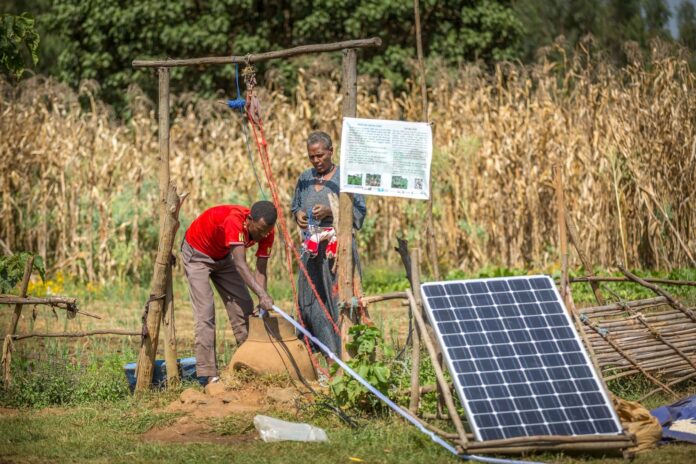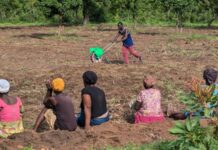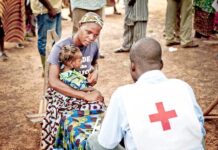A recent study by Ogunboyo, P. T., & Ogunlade, O. (2024) titled “Review of Photovoltaic Energy Access for Sustainable Growth in the Agricultural Sector: Economic, market and Employment Opportunities for Rural Communities of Sub-Saharan African” published in Applied Photovoltaic Technology shows that the use of photovoltaic energy in agriculture could lead to economic development and employment opportunities in rural communities.
“
Integrating photovoltaic energy into agriculture in Sub-Saharan Africa can drive economic development and EMPLOYMENT. –Ogunboyo, P. T., & Ogunlade, O. (2024)
The article delves deeply into the profound Impact of Photovoltaic Energy on Agriculture. Within the agricultural landscape of Sub-Saharan Africa, the study scrutinizes how the adoption of photovoltaic solar energy can act as a catalyst for sustainable growth. This involves exploring how such energy sources can contribute to long-term agricultural practices that maintain or enhance soil fertility, conserve water resources, and minimize environmental degradation, thereby ensuring the viability of farming operations for future generations. The research extensively investigates the multifaceted economic opportunities arising from the integration of photovoltaic energy into agricultural practices. This includes analyzing the potential for revenue generation through the sale of surplus energy back to the grid, creating new markets for solar-powered agricultural technologies, and fostering entrepreneurship and job creation within rural communities through the development and maintenance of solar infrastructure. A pivotal aspect of the study involves delving into the myriad environmental benefits associated with photovoltaic energy adoption in agriculture. By tapping into this clean and inexhaustible energy source, farmers can reduce their reliance on fossil fuels, thereby mitigating greenhouse gas emissions and contributing to climate change mitigation efforts. Additionally, the study explores how the deployment of solar-powered irrigation systems and other renewable energy technologies can help conserve natural resources and protect fragile ecosystems in Sub-Saharan Africa. In addition to highlighting the transformative potential of photovoltaic energy in agriculture, the study meticulously examines the challenges and barriers that may impede its widespread adoption. These may include technological limitations, financial constraints, and regulatory hurdles. To address these challenges, the study offers a range of policy recommendations aimed at promoting the uptake of photovoltaic energy in agriculture, such as providing financial incentives for solar energy investment, facilitating access to affordable financing options for farmers, and streamlining regulatory processes to expedite the deployment of solar infrastructure. In essence, the study provides a comprehensive analysis of the complex interplay between photovoltaic energy and agriculture in Sub-Saharan Africa, shedding light on the opportunities, challenges, and policy interventions necessary to realize the full potential of this transformative energy source in driving sustainable agricultural development and rural prosperity.
How the Study was Conducted
This study employed a systematic review approach to investigate the integration of photovoltaic solar energy in agricultural applications, particularly focusing on its role in improving energy access and quality in rural areas of Sub-Saharan African countries. The research aimed to assess the potential impact of photovoltaic systems on agricultural practices and rural development, with a specific emphasis on the generation of employment opportunities.
The systematic review process involved the comprehensive examination of various scholarly works, research articles, reports, and other relevant literature pertaining to photovoltaic solar energy and its electrification in agricultural contexts. A rigorous search strategy was devised to identify relevant studies from reputable academic databases, journals, and institutional repositories.
The inclusion criteria for the review encompassed studies that discussed the application of photovoltaic systems in agricultural settings, including but not limited to solar energy utilization for cooling storages, water pumping for irrigation purposes, greenhouse heating/cooling, and crop drying. Studies focusing on economic analysis and market-related opportunities associated with photovoltaic systems were also considered.
Upon identification of relevant literature, a thorough screening process was undertaken to select studies that met the predefined inclusion criteria. The selected studies were then critically appraised to extract key findings, methodologies, and insights pertaining to the integration of photovoltaic energy in agriculture and its potential implications for rural development in Sub-Saharan Africa.
What the Authors Found
The authors found that Sub-Saharan Africa has a significant potential for photovoltaic solar energy, estimated at about 10,000 GW. The authors also posit that the use of photovoltaic energy in agriculture could lead to economic development and employment opportunities in rural communities. In addition, photovoltaic solar energy is a clean, non-pollutant source of energy that can help reduce greenhouse gas emissions and combat climate change.
Why is this Important
Energy Access: Photovoltaic systems provide a reliable and sustainable source of energy for rural communities. In regions where traditional grid infrastructure is lacking or unreliable, solar energy can bridge the gap and improve access to electricity.
Agricultural Productivity: Access to electricity enables farmers to use modern agricultural technologies, such as irrigation pumps, refrigeration for crop storage, and machinery. These tools enhance productivity, crop yield, and overall farm efficiency.
Economic Growth: The adoption of photovoltaic technology creates employment opportunities. Local installation, maintenance, and operation of solar systems generate jobs, contributing to economic development in rural areas.
Environmental Benefits: Solar energy is clean and renewable. By reducing dependence on fossil fuels, it helps mitigate climate change and minimizes environmental pollution.
Resilience and Adaptation: Photovoltaic systems can withstand extreme weather conditions, making them suitable for remote and vulnerable regions. They enhance community resilience by providing a consistent energy supply.
Sustainable Development Goals (SDGs): The use of solar energy aligns with several SDGs, including affordable and clean energy (SDG 7), climate action (SDG 13), and partnerships for sustainable development (SDG 17).
What the Authors Recommend
- The authors recommend that governments and policymakers should create favorable policies and incentives to encourage the deployment of photovoltaic systems. This includes subsidies, tax breaks, and streamlined regulations.
- The authors suggest that policymakers should raise awareness among farmers, local communities, and relevant stakeholders about the benefits of solar energy. Educational programs can help dispel myths, address misconceptions, and promote informed decision-making.
- The study also ought government to invest in training programs for technicians, installers, and maintenance personnel. Building local expertise ensures the effective installation and operation of photovoltaic systems.
- In addition, the authors suggest that the government should develop innovative financing models, microcredit schemes, and community-based financing options. These mechanisms can make solar energy more accessible to small-scale farmers and cooperatives.
- Foster collaboration between governments, NGOs, research institutions, and private sector entities. Partnerships can accelerate technology transfer, knowledge sharing, and project implementation.
- Involve local communities in decision-making processes. Engage farmers, women’s groups, and youth to ensure that solar energy projects align with their needs and aspirations.
In conclusion, the study underscores the immense potential of integrating photovoltaic energy into agricultural practices in Sub-Saharan Africa. By addressing energy access challenges, enhancing agricultural productivity, fostering economic growth, and mitigating environmental impact, solar energy emerges as a pivotal driver for sustainable rural development. However, realizing these benefits requires concerted efforts from governments, policymakers, stakeholders, and local communities to overcome barriers and implement supportive policies. Through collaborative action and innovative solutions, the vision of harnessing solar energy for transformative agricultural growth can be realized, leading to a brighter, greener, and more prosperous future for rural communities across the region.
















 The African Research (AR) Index is a comprehensive scholarly directory and database focused explicitly on journal publishers that publish and disseminate African research.
The African Research (AR) Index is a comprehensive scholarly directory and database focused explicitly on journal publishers that publish and disseminate African research.

